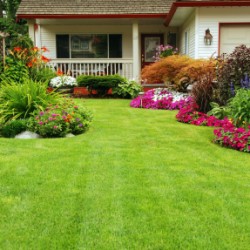
Not everyone can afford a lawn care service. If you care for your own yard, here are some tips from a lawn care professional, on how to keep your lawn looking beautiful.
1) Only cut 1/4″ to 1/3″ of the grass height off in a single cut. This will allow your lawn to be the healthiest with this technique.
The height in which you cut your lawn will depend on the type of grass you have and how much shading or exposure the lawn has to the sun. If after you mow, your grass goes from green to brown and dry looking, this is usually a good sign you are cutting too much off or cutting it too low.
2) Only water in the early morning. Set your sprinklers to run from 3AM – 5 AM. If you move sprinklers by hand, do it in the early morning. The sun comes up and drives out the lawn, so you do not have sitting water in your grass for long periods of time. Water lying in the grass through the night can contribute to grass disease and fungi, which may kill your entire lawn.
3) Depending on the soil, it is usually better to water for longer periods of time and fewer times per week. By doing this, you fill the soil’s “reservoir” and let the roots grow deeper to absorb the water as it is used up.
The opposite applies when the grass is watered shorter periods with more frequent watering. This creates a shallow root system for the grass which is not as healthy and easier to damage.
(If you live in a rocky area where topsoil has been filled in when landscaping, depending on how thick the layer of topsoil is, determines how much your soil will hold. You’ll need to assess your particular situation. Poor landscaping results in an unattractive lawn for years to come and usually is not a easy fix. It is worth doing it right the first time)!
4) In the south, web worms, chinch bugs, and click beetles can be a problem, especially from watering the lawn at dusk and the water doesn’t dry up before the sun goes down.
If you see a lot of white moths flying over your lawn in the spring, they are adult webworms getting ready to lay their eggs. The webworms chew at the base of the stems of grass until the grass turns yellow and can eventually die. You can see them by pouring soapy water on a spot in your lawn and it will bring them to the surface.
Chinch bugs suck the moisture and sap from grass causing yellow patches that can spread quickly. They quickly move into lawns that are poorly tended and have thatch. They quickly chew away at the base of the grass causing the grass to die. Your lawn can be destroyed in a very short time, so treatment is needed very quickly.
The click beetle can also be a problem and is found were water is allowed to lie and grass stay moist. They feed on roots and are usually seen in May and June.
5) Aeration is good to do in the Spring and Fall. By aerating, you loosen the compacted soil and allow nutrients and water to penetrate deeper and directly to the roots creating a healthier root system. This process can also help keep bugs out of your lawn.
6) Fertilizing is very important for maintaining a green and healthy lawn. You will notice there are three numbers on the fertilizer bag. They stand for Nitrogen, Phosphorous, and Potassium. Nitrogen promotes top growth by creating more chlorophyll which makes your grass grow faster and require more mowing; phosphorous helps create and develop a strong root system, which is vital for a healthy lawn to be able to absorb sufficient water; and potassium which works like a defense mechanism that protects grass from disease and other harsh conditions, such as hot summers and harsh winters.
It is recommended to fertilize at least three times a year. Fertilize in Spring, Summer, and Fall. Spring allows your grass to green up and get “off on the right foot.” Summer fertilizing maintains your green lawn and gives it nutrients to endure the hot summer, and Fall to feed the roots during the winter months. Slow-release fertilizer is the best because it allows the grass to be fed slower and for a longer amount of time.
In Spring and Fall, the grass roots are growing the most because the temperatures are ideal and there is may be more precipitation. During the summer, lawns go into a survival state and preserve their resources and energy to survive the hot summers. Allow about ten weeks in between fertilizing to keep your lawn beautiful. If your fertilizer contains iron, make sure you sweep/blow off the concrete because it will stain the concrete. Iron makes your grass deep green.
Be prepared to start watering right away after the fertilizer is spread and keep lots of water on your lawn so it does not burn up with the fertilizer. Watering in the early morning is the best time of the day to water. Make sure you follow the directions on the fertilizer bag and it is recommended to buy the same brand spreader as the fertilizer that you have purchased. The spreader is designed to work well with the company’s fertilizer.
Follow these simple guidelines and your lawn will look its best.
